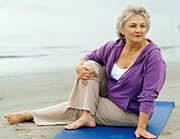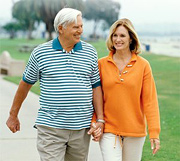A Universal Concern
In the United States, a senior citizen is defined as someone able to retire with full Social Security benefits at age 65. Regardless of whether you have reached that age yourself, or have parents and grandparents who fit into that category, it is important to understand and appreciate the unique health problems faced by seniors – along with possible health solutions – to help serve, honor and respect those who have spent much of their lives supporting the younger generation.
Fear of Falling
I vividly remember a television commercial that aired many years ago about an elderly person who, after falling down, cried out, “Help! I’ve fallen, and I can’t get up!” When I first saw the commercial as a young man, I must admit I found it somewhat humorous. But I have learned that seniors do not think that commercial is funny at all. Why? The reason is that most seniors have a very real fear of falling – and a much deeper fear of not being able to get up afterward. Falls are inevitable, but by staying active and physically fit, seniors can keep their spines flexible, and at the same time, maintain their strength and coordination.
Seniors lose height in their intervertebral discs as they age because the cartilage dries out and degenerates. The spinal vertebrae (there are 26 total) get compressed and lose mass. The facet joints become arthritic. The characteristic “widow’s hump” often exaggerates – especially in former office workers, accountants and bookkeepers, who spent most of their daily lives hunched over at desks.
Compression fractures commonly result in elderly patients not being able to touch their head to the pillow when lying on their back in bed. Shoulder and neck mechanics can be altered, including a stiff, restricted neck and limited shoulder motion; loss of flexibility, poor posture (skeletal misalignment and imbalance), and weak muscles (strength loss). This aging process – often combined with past traumas – results in what we as chiropractors call “subluxations.”
Keeping the Spine in Shape
Believe me, restoring joint mobility and nerve function through chiropractic adjustments really works! One of the most gratifying patient encounters I have ever had occurred at a senior facility when a patient handed me his walker and said, “Doc, I want to give this to you … because I will not be needing it anymore!” The goal for optimum senior functioning is to achieve at least 80 degrees of rotation in their neck if they are still driving, and 60 degrees of rotation if they are no longer driving. In terms of their peripheral body movement, seniors need at least 160 degrees of shoulder flexion and 60 degrees of straight-leg rising. Doctors of chiropractic can monitor a senior’s range of motion and help improve spinal restrictions caused by subluxations and muscle imbalance through regular chiropractic adjustments.
By concentrating on neck and lower back exercises that improve flexibility, posture, and strength, the senior can dramatically enhance the chiropractic care he/she is receiving. And remember, many doctors of chiropractic practice non-force techniques that are preferred for the more severely compromised spines that have arthritis, osteoporosis and any developmental anomalies.
Staying Young
All in all, not a very pretty picture! So, what are the solutions? Simply put, seniors need to stay active as long as they possibly can. They should attempt housework, yard work and hygienic practices daily. The toughest patients are the ones who lie around in bed and lose almost all interaction with others. For that reason, I recommend against seniors having a television set in their bedroom. If they want to watch television, they should come out to the den or living room and interact with the family or other residents (if in a nursing home).
 Seniors in independent or assisted-living facilities should be encouraged to attend the daily exercises offered by the activities director. In my opinion, this should not be optional; it is essential. For seniors who exercise on their own, they should keep a log or journal that tracks progress from week to week. They also should be encouraged to share it with an “accountability partner” for support and positive feedback.
Seniors in independent or assisted-living facilities should be encouraged to attend the daily exercises offered by the activities director. In my opinion, this should not be optional; it is essential. For seniors who exercise on their own, they should keep a log or journal that tracks progress from week to week. They also should be encouraged to share it with an “accountability partner” for support and positive feedback.
In regard to electric scooters, I discourage their use, as they promote further weakness and muscle atrophy. In terms of walkers, I prefer models that allow the senior to sit down. This is important if the senior plans on staying at one location for a long period of time or if they are weak and prone to falls. In my opinion, a “cage-style” scooter is generally best if a senior has suffered three or more unexplained falls.
Many seniors take far too many prescriptions and over-the-counter medications for their various pains and conditions. Sadly, a potential side effect from ingesting so many medications is that it causes the patient to become extremely disoriented, which can lead to dizziness and periodic falls. Chiropractic treatment can help them avoid using so many drugs. Less pain and fewer health problems leads to fewer drugs and their accompanying side effects.
Finally, the foods seniors eat are very important. A diet emphasizing vegetables, fruits, nuts, whole grains, lean meat and coldwater fish is ideal – for people of all ages. Vitamin D supplements are also promising, in conjunction with calcium/magnesium, to combat metabolic bone diseases that often affect seniors.
By Gregory B. Sheppard, DC
